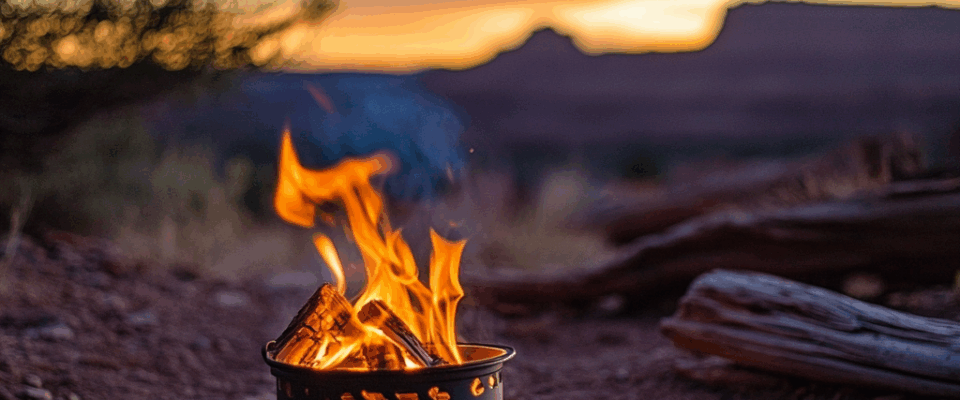Portability and Setup Time
When you’re deep in the wilderness, every ounce and minute count. Gas stoves are lightweight, compact, and designed for fast deployment. Most models can be set up in under a minute and require minimal effort, which is perfect for hikers and backpackers who value efficiency. Their consistent structure and integrated fuel source make them an ideal solution for quick meal preparation, especially after a long hike.
In contrast, setting up a campfire is often time-consuming and depends heavily on external conditions. Gathering dry wood, building a proper fire ring, and igniting the flame can take anywhere from 15 to 30 minutes—or longer if it’s wet or windy. Campfires also require a steady hand and some skill to build safely and effectively. For those with limited time or energy, this process can be a hassle.
Fuel Availability and Efficiency
Gas stoves run on small, portable canisters filled with propane, butane, or isobutane, offering a clean and efficient energy source. These canisters burn steadily regardless of weather and altitude, providing predictable performance. You know exactly how much fuel you have, and you can usually boil a liter of water in just a few minutes with minimal waste.
On the other hand, campfires rely on the availability of natural fuel sources like dry wood, twigs, or branches. While this may seem convenient, it’s not always guaranteed. Wet environments, overused campsites, or areas above the tree line may not have adequate fuel. Additionally, fires burn unevenly and require constant attention, often leading to inefficient cooking and more time spent managing the flame.
Cooking Versatility and Temperature Control
Gas stoves shine when it comes to precise cooking. Most models allow users to adjust the flame easily, making it possible to simmer, boil, or lightly fry food without burning it. This level of control enables more variety in meals and ensures better outcomes, even with delicate dishes or rehydrated backpacking meals.
Campfires, while potentially offering multiple cooking surfaces (like grill grates or heated rocks), are much harder to regulate. Heat distribution is uneven, and flare-ups or dying coals can ruin meals if you’re not constantly watching. Unless you’re an experienced outdoor cook, preparing food over an open fire can be unpredictable and limited in scope.
Safety Considerations
Using a gas stove is generally much safer than building a campfire. Gas stoves operate with a controlled flame and are less likely to cause unintended wildfires when used correctly. They also don’t require open flames in the ground, which can be hazardous in dry or windy conditions. Most modern stoves also feature safety valves and automatic ignitions.
In contrast, campfires come with a higher risk factor. Sparks can jump from the fire and ignite nearby brush, especially in dry climates. Even a well-managed fire can accidentally spread if not fully extinguished. Additionally, managing hot coals and embers presents burn risks, especially in the dark or when tired after a long day on the trail.
Environmental Impact and Leave No Trace Principles
Gas stoves have a significantly lower environmental footprint compared to campfires. They produce no ash, don’t scar the ground, and leave behind no trace if the canisters are packed out properly. This aligns perfectly with Leave No Trace principles, promoting responsible use of natural spaces and minimizing human impact.
Campfires, on the other hand, can damage soil, leave permanent black marks on rocks, and deplete the local supply of downed wood that wildlife depend on. In high-traffic areas, repeated fire building can destroy vegetation and disturb ecosystems. Even when done with care, a campfire alters the landscape in visible and lasting ways.
Legal Restrictions and Trail Regulations
When planning your outdoor adventure, it’s essential to consider the legal restrictions that may influence your cooking choice. Many trails, national parks, and wilderness areas enforce strict rules about open flames. Campfires may be banned altogether, especially during fire season or in high-risk zones, to prevent wildfires and protect delicate environments.
Before setting out, always check with the local ranger station or official website for up-to-date regulations. Rules vary depending on location, weather, and season. Here’s a breakdown of common policies:
- Campfires are often prohibited above certain elevations due to lack of available fuel and environmental fragility.
- During dry or windy conditions, fire bans are frequently issued that only allow gas stove usage.
- Some parks require fire permits for any open flame, including gas stoves, especially in backcountry zones.
- In heavily trafficked areas, fires may be banned to reduce environmental degradation and litter.
- Violating fire regulations can result in heavy fines, or even cause forest closures if a wildfire occurs.
Staying informed about these rules not only keeps you safe but helps protect the trails for future hikers. In areas where campfires are banned, gas stoves become the only viable option, making them not just more convenient—but often the only legal choice.
Question and Answer
Answer 1: A gas stove is quicker to set up than a campfire.
Answer 2: Gas canisters are more reliable than natural wood.
Answer 3: Gas stoves offer better temperature control.
Answer 4: Gas stoves are safer in dry or windy conditions.
Answer 5: Fire bans often make gas stoves the only legal op

